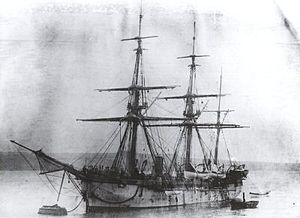HMS Egeria (1873)

HMS Egeria
|
|
| History | |
|---|---|
|
|
|
| Name: | HMS Egeria |
| Builder: | Pembroke Royal Dockyard |
| Cost: | Hull £32,468, machinery £10,414 |
| Laid down: | 30 December 1872 |
| Launched: | 1 November 1873 |
| Completed: | November 1874 |
| Reclassified: | As survey ship, October 1886 |
| Fate: | Sold, October 1911 |
| General characteristics | |
| Class and type: | Fantome-class sloop |
| Displacement: | 949 long tons (964 t) |
| Tons burthen: | 727 bm |
| Length: | 160 ft (48.8 m) (p/p) |
| Beam: | 31 ft 4 in (9.6 m) |
| Draught: | 14 ft (4.3 m) |
| Depth: | 15 ft 6 in (4.7 m) |
| Installed power: | 1,011 ihp (754 kW) |
| Propulsion: |
|
| Sail plan: | Barque rig |
| Speed: | 11 knots (20 km/h; 13 mph) |
| Range: | 1,000 nmi (1,900 km; 1,200 mi) at 10 knots (19 km/h; 12 mph) |
| Complement: | 125 |
| Armament: |
|
HMS Egeria was a 4-gun screw sloop of the Fantome class launched at Pembroke on 1 November 1873. She was named after Egeria, a water nymph of Roman mythology, and was the second ship of the Royal Navy to bear the name. After a busy career in the East Indies, Pacific, Australia and Canada, she was sold for breaking in 1914 and was burnt at Burrard Inlet in British Columbia.
Egeria was constructed of an iron frame sheathed with teak and copper (hence 'composite'), and powered by a two-cylinder horizontal compound-expansion steam engine. This engine, provided by Humphrys, Tennant & Co., drove a single 11-foot (3.4 m) diameter screw and generated an indicated 1,011 horsepower (754 kW). Steam was provided by three cylindrical boilers working at 60 pounds per square inch (4.1 bar).
In 1875, Egeria, commanded by Commander Ralph Lancelot Turton, proceeded to Perak (in modern Malaysia), as one of a squadron of six ships under Captain Alexander Buller with his senior officer’s pennant in HMS Modeste, to take part in an expedition against the murderers of Mr James Birch, the British Resident in Perak. While the troops and a naval brigade advanced on the upper reaches of the Perak River simultaneously from two points, Egeria blockaded the Perak Littoral, and sent her boats up the Kurow River. These boats destroyed or carried off some guns, arms, and ammunition which might have been useful to the enemy. Severe punishment was inflicted on the natives, but the murderers were not brought to account for some time afterwards.
During the Russo-Turkish War of 1877–1878, Egeria, commanded by Commander Archibald Douglas, was sent on an intelligence gathering mission to Petropavlovsk in Kamchatka. It was found to have been abandoned by its Russian garrison.
...
Wikipedia
